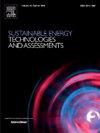A novel adaptive hydro-wind-photovoltaic integrated base short-term scheduling solution: Considering sudden water pollution incidents
IF 7.1
2区 工程技术
Q1 ENERGY & FUELS
Sustainable Energy Technologies and Assessments
Pub Date : 2025-04-01
DOI:10.1016/j.seta.2025.104296
引用次数: 0
Abstract
Hydro–wind–photovoltaic complementarity is an important way to promote new energy consumption. Aiming at the demand for emergency dispatching for sudden water pollution incidents in cascade hydropower stations, this paper proposes a short-term optimal scheduling solution for hydro-wind-photovoltaic integrated base considering sudden water pollution incidents. Firstly, a day-ahead dispatching model is established, and the DBO algorithm is employed to determine the optimal day-ahead dispatching plan. Secondly, an emergency dispatching model is established with the objective of the shortest pollutant arrival time and the largest concentration accumulation value. The power generation plan deviation as the constraints to formulate an emergency dispatching plan after a sudden water pollution incident. Finally, a hydro-wind-photovoltaic integrated base under construction in Guizhou Province, China, is used as an example for the study. The results show that the emergency dispatching plan does not significantly reduce the system power generation performance (the average daily power generation decreases by only 0.27%, and the residual load fluctuation increases by only 0.15%), but it can shorten the pollutant arrival time by 10.76%, increase the concentration accumulation value by 1.61%, and improve the ability of the integrated base to cope with the sudden pollution incidents.
一种考虑突发性水污染事件的自适应水风光伏一体化基地短期调度新方案
水风互补是促进新能源消费的重要途径。针对梯级水电站突发性水污染事件应急调度需求,提出了考虑突发性水污染事件的水风光伏综合基地短期最优调度方案。首先,建立日前调度模型,采用DBO算法确定最优日前调度方案;其次,以污染物到达时间最短、浓度积累值最大为目标,建立了应急调度模型;以发电计划偏差为约束,制定突发性水污染事件应急调度方案。最后,以中国贵州省正在建设的水风光伏一体化基地为例进行研究。结果表明,应急调度方案并未显著降低系统发电性能(日均发电量仅下降0.27%,剩余负荷波动仅增加0.15%),但可使污染物到达时间缩短10.76%,浓度积累值提高1.61%,提高综合基地应对突发污染事件的能力。
本文章由计算机程序翻译,如有差异,请以英文原文为准。
求助全文
约1分钟内获得全文
求助全文
来源期刊

Sustainable Energy Technologies and Assessments
Energy-Renewable Energy, Sustainability and the Environment
CiteScore
12.70
自引率
12.50%
发文量
1091
期刊介绍:
Encouraging a transition to a sustainable energy future is imperative for our world. Technologies that enable this shift in various sectors like transportation, heating, and power systems are of utmost importance. Sustainable Energy Technologies and Assessments welcomes papers focusing on a range of aspects and levels of technological advancements in energy generation and utilization. The aim is to reduce the negative environmental impact associated with energy production and consumption, spanning from laboratory experiments to real-world applications in the commercial sector.
 求助内容:
求助内容: 应助结果提醒方式:
应助结果提醒方式:


